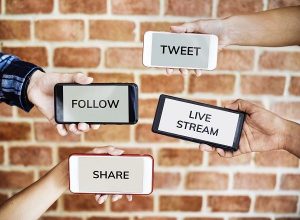ALL YOU NEED TO KNOW ABOUT DIGITAL MARKETING
With the expanding usage of internet today, the number of individuals surfing the web is increasing day by day. The manner in which individuals surf and shop truly has changed overtime – where the highest number of shopping is moving to online which means offline marketing is no longer as effective as it used to be. Advertising and marketing has consistently been about connecting businesses and consumers, or businesses with businesses, and in today’s world that implies you have to meet your customers where they are investing their energy and time: On the internet.
Overview
 Digital marketing incorporates utilization of marketing activities through electronic gadget or the web. Organizations benefit from digital channels, for example, search engines, social media, email, and various sites/microsites/landing pages in order to connect with present and new clients.
Digital marketing incorporates utilization of marketing activities through electronic gadget or the web. Organizations benefit from digital channels, for example, search engines, social media, email, and various sites/microsites/landing pages in order to connect with present and new clients.
Digital Marketing Role to an Organization
Traditionally, the role of marketing included advertising, print promotions, selling, or physical showcasing, digital marketing is taking place online and electronically. In view of this, there are unlimited opportunities for organizations to get their brand and image online through various digital activities such by means of email promoting, drawing in recordings, internet-based life, or site-based advertising openings.
Today, digital marketing is crucial for any business as it provides measurable brand awareness and results. As content is increasingly important, online customers are relying on it as it becomes important part of their customer journey and loyalty to a brand. In order to remain competitive, business owners must embrace the benefits of digital marketing grasping all the ways their business can take the advantage of all its offerings.
Since digital marketing offers such variety of options and various strategies in achieving results, we suggest that you get inventive and try various options with an assortment of showcasing strategies on a carefully planned budget.
How does a business characterize Digital Marketing?
Digital marketing is characterized by the utilization of different online strategies, tactics, growth hacking fundamentals and channels to interface with clients where they invest quite a bit of their time and energy: on the web. From the site itself to a business’ digital assets, digital marketing encompasses all types such as email marketing, social media paid advertising, online brochures and e-papers, case studies, and beyond – there’s a range of strategies that fall under the umbrella.
Given the ideal brief and targets of your business, digital marketing creates a clear image of how each online effort will bolster your objectives. Contingent upon the objectives of your marketing strategies and aims, digital marketing activities support organizations can bolster a bigger crusade through both free and paid channels – each giving advantages to your business.
For instance, through creation of multiple blog posts that serve the purpose of generating the leads, these can be promoted through both paid and organic posts, and blasted to your database or through third party platforms promoting people to download and this way obtaining their interest.
Different Types of Digital Marketing
1. Search Engine Optimization (SEO)
2. Content Marketing
3. Social Media Marketing
4. Pay Per Click (PPC)
5. Affiliate Marketing
6. Native Advertising
7. Marketing Automation
8. Email Marketing
9. Online PR
10. Inbound Marketing
11. Sponsored Content
Following is a review of probably the most widely recognized digital strategies and the channels:
Search Engine Optimization (SEO)
Web optimization is the way toward optimizing your website in order to appear and rank higher on search pages, for example, Google, which implies you are expanding the measure of natural (or free) traffic you to your site. Website, blogs and infographics are some of the main channels that benefit from SEO.
The following are a few different ways to execute SEO so as to produce qualified traffic to your site:
• On page SEO: This kind of SEO centers around all substance that is found “on the page”, that is all the page content. By examining keywords for their search volume and purpose (or importance), you can address inquiries for users and rank higher on the internet searcher results pages (SERPs).
• Off page SEO: This sort of SEO centers around all activities that happes “off the page” when hoping to upgrade your site, for example, inbound connections/links, otherwise called backlinks. The quantity of distributers that connect to you, and the relative “authority” of those distributers, influence how profoundly you rank for the catchphrases/keywords applicable to your business. By networking with different publishers, composing visitor posts on these sites (and connecting back to your site), and creating external attention, you can earn the backlinks and moving your site up on all the privilege of SERPs.
• Technical SEO: This kind of SEO centers around the backend of your site, and how your pages are coded. Picture compression, structured data, and CSS record optimization are all the various types of specialized SEO that can help expanding your site loading time – a significant positioning variable according to search engines like Google.
Content Marketing
 Content marketing is progressively significant as it helps with the creation and promotion of content assets for the purpose of creating stronger brand exposure, traffic increase, inquiries, and new clients. Following are key channels that have significant influence in the content strategy:
Content marketing is progressively significant as it helps with the creation and promotion of content assets for the purpose of creating stronger brand exposure, traffic increase, inquiries, and new clients. Following are key channels that have significant influence in the content strategy:
• Blog posts: Crafting unique content as a blog or a story helps with the accurate or desired positioning of your organization to positioning the company as industry leader and moreover it produces organic traffic to your site. This at last gives you more chances to turn users into leads.
• E-books and whitepapers: Ebooks, whitepapers, and comparative content further assists the users on the site by providing compelling information they might be looking for. It additionally allows you to exchange content for a user’s contact information, creating leads for your organization and moving individuals through the overall customer journey.
• Info-graphics: Info-graphics are a type of visual material that enables site visitors to envision an idea of the content while summarizing the key ingredients representing it visually, which in turn educates the target audience about your company, the products and services.
Social Media Marketing
 Social media are various online platforms that assist a company with enhancing their image, promoting the brand, content, and images that all contribute to enhance the brand awareness, traffic, and create client requests. The channels include:
Social media are various online platforms that assist a company with enhancing their image, promoting the brand, content, and images that all contribute to enhance the brand awareness, traffic, and create client requests. The channels include:
• Facebook
• Twitter
• LinkedIn
• Instagram
• Snapchat
• Pinterest
• Tik Tok
Having business nearness on these stages is getting progressively imperative to organizations as it gives you the opportunity to attract and inform current clients and entice new clients and prospects.
Pay Per Click (PPC)
PPC is a technique for directing people to your site by paying a distributer each time your advertisement is clicked. One of the most well-known kinds of PPC is Google Ads, which permits you to pay for top spaces on Google’s web index results pages at a cost “per click” of the connections you place. Different channels where you can utilize PPC include:
• Paid promotions on Facebook: Here, clients can pay to modify a video, picture post, or slideshow, which Facebook will distribute to the news feeds of individuals who coordinate your business’ audience
• Twitter Ads: Users can pay to put a progression of presents or profile identifications on the news sources of a particular audience, all devoted to achieving a particular objective for your business. This objective can be site traffic, more Twitter supporters, tweet commitment, or even application downloads, and new clients.
• Sponsored Messages on LinkedIn: Users can pay to send messages straightforwardly to explicit LinkedIn profiles dependent on their industry, titles and areas.
Affiliate Marketing
This is a kind of performance-based marketing where you get commission for advancing another person’s products/services on your website. Partner advertising channels include:
• Hosting video advertisements through the You Tube Partner Program
• Posting partner links from your web-based social networking accounts
Native Advertising
Native advertising alludes to commercials that are basically content-driven and included on platform by other, non-paid advertisements. BuzzFeed sponsored content are a great example, however numerous individuals likewise consider social media ads as native such as Facebook and Instagram promotions.
Marketing Automation
Marketing automation is innovation within technology and software’s, ramming that oversees promoting multi-functional digital campaigns, over numerous channels automatically. With marketing automation, organizations can target clients with automated and custom-made messages across email, web, social, and content. Messages are sent consequently, as indicated by sets of guidelines called work process, instead of physically sparing you a lot of time. Work processes might be characterized by formats, custom built, or changed to accomplish better outcomes.
• Emailers & newsletters: Email automation doesn’t simply permit you to naturally send messages to your subscribers. It can likewise assist you with contracting and growing your contact list focusing only on those individuals who wish to get them in their inboxes.
• Social media post planning: If you need to develop your brand essence on social media platforms for your organisation, you schedule your posts as often as possible. This makes manual posting a touch of a boisterous procedure. Social media scheduling software’s can push your company content to all the networking channels for you, so you can invest more energy concentrating on content methodology and strategies.
• Lead-nurturing work processes: Preparation of campaigns that will turn into high performance and generate the leads, converting them to clients, can be a long and tricky procedure. You can automate that procedure by sending leads or inquiries specific information, for example, an e-book, brochure etc.
• Campaign tracking & reporting: Marketing efforts can incorporate a huge number of various individuals, messages, content, website pages, calls, and the sky is the limit from there. Marketing automation can assist you with arranging all various work into one direction and track performance of each campaign based on the progress of all of the variables over time.
Email Marketing
Organizations use email marketing as a method of communicating directly with their target audience. Email is extensively used to promote various content, discounts, events, promotions and more, further directing the target audience to a website, microsite or landing page of your organization. Following are types of email marketing campaigns:
• Blog membership bulletins / newsletters
• Follow-up messages to site visitors who visited or download a document
• Customer welcome messages
• Seasonal / holiday promotions to loyalty programs and members
• Tips or comparative content for client nurturing
• Promotional lead generation emails for new products / services / offers
Online PR
Online PR is the act of protecting earned online coverage with online publications, web journals, blogs and other content-based websites. It is a lot of like conventional PR, however in the online space. The channels you can use to augment your PR endeavors include:
• Reporter outreach by means of online social platforms: Conversing with journalists on Twitter, for instance, is an incredible method used to build up a relationship with the press that produces earned media open doors for your organization.
• Engaging reviews of the organizations: When somebody provides their online reviews of your organization, regardless of whether that review is positive or negative, your nature may be not to interact with it. Despite what might be expected, humanizing your brand by providing valuable responses is considered a powerful move for your company in the eye of your target audience allowing you to portray a positive image and convey ground-breaking informing that secures your notoriety.
• Engaging remarks on your own site or blog: Similar to the manner in which you’d react to reviews of your organization, reacting to the individuals who are reading your content is the most ideal approach to create gainful conversation around your industry.
Inbound Marketing
Inbound advertising alludes to a promoting approach wherein you draw in, connect with, and engage with prospects at each phase of their purchaser’s journey. You can utilize each method of the digital strategies outlined above, all through an inbound marketing strategy, to make a client experience positive cooperation with them, and not against them. Here are some exemplary instances of inbound marketing versus conventional outbound marketing:
• Blogging versus pop-up advertisements
• Video advertising versus commercial advertising
• Email contact records versus email spam





 Independent of your company location, digital experts are able to target your clients/prospects anywhere in the world – instantly. When targeting internationally and based on nature of each location, there are certain variables that agencies such as Blupord adapt in order to successfully execute each digital requirement. Following are a few important variables:
Independent of your company location, digital experts are able to target your clients/prospects anywhere in the world – instantly. When targeting internationally and based on nature of each location, there are certain variables that agencies such as Blupord adapt in order to successfully execute each digital requirement. Following are a few important variables:

 Digital marketing incorporates utilization of marketing activities through electronic gadget or the web. Organizations benefit from digital channels, for example, search engines, social media, email, and various sites/microsites/landing pages in order to connect with present and new clients.
Digital marketing incorporates utilization of marketing activities through electronic gadget or the web. Organizations benefit from digital channels, for example, search engines, social media, email, and various sites/microsites/landing pages in order to connect with present and new clients. Content marketing is progressively significant as it helps with the creation and promotion of content assets for the purpose of creating stronger brand exposure, traffic increase, inquiries, and new clients. Following are key channels that have significant influence in the content strategy:
Content marketing is progressively significant as it helps with the creation and promotion of content assets for the purpose of creating stronger brand exposure, traffic increase, inquiries, and new clients. Following are key channels that have significant influence in the content strategy: Social media are various online platforms that assist a company with enhancing their image, promoting the brand, content, and images that all contribute to enhance the brand awareness, traffic, and create client requests. The channels include:
Social media are various online platforms that assist a company with enhancing their image, promoting the brand, content, and images that all contribute to enhance the brand awareness, traffic, and create client requests. The channels include: